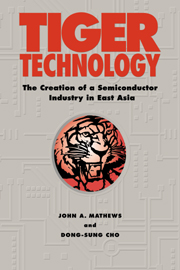Introduction
Published online by Cambridge University Press: 09 October 2009
Summary
The rise of East Asia as a global economic power has been one of the great transformation processes of our time. Countries such as Korea, Taiwan and Singapore, which a generation ago had lain in poverty, have lifted themselves up to become generators of wealth through manufacturing and trade. Their success has overturned earlier approaches to economic development, in that the East Asian countries were outward rather than inward-oriented; their success was based on integration into the world economy through exports, technology transfer and access to foreign capital. This success was also founded on innovations in political economy, such as savings mechanisms for the accumulation of capital, the formation of developmental consortia for the rapid deployment of technological upgrading, and ‘pilot’ or steering agencies of government to coordinate investment, which have no counterpart in the developmental traditions of Western countries.
The sources of what the World Bank came to call the ‘East Asian miracle’ (1993) have been the subject of prolonged scholarly debate. Early attempts to come to grips with the magnitude of these countries' achievements tended to be polarised. On the one hand there were strong proponents of the view that the ‘miracle’ was the outcome of unfettered market forces and responsible, minimalist government intervention to ‘get prices right’. On the other hand, there were scholars who saw in the ‘miracle’ the guiding hand of strong developmental states whose agencies intervened in the economy to ‘get prices wrong’ (Amsden 1989) – that is, to steer the economies towards investment and development targets which would otherwise lie beyond their capacities.
- Type
- Chapter
- Information
- Tiger TechnologyThe Creation of a Semiconductor Industry in East Asia, pp. 1 - 26Publisher: Cambridge University PressPrint publication year: 2000
- 1
- Cited by



